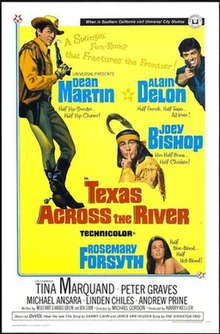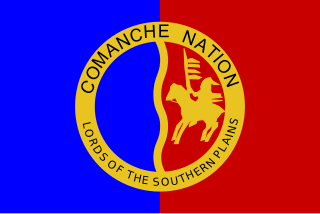
The Comanche or Nʉmʉnʉʉ is a Native American tribe from the Southern Plains of the present-day United States. Comanche people today belong to the federally recognized Comanche Nation, headquartered in Lawton, Oklahoma.

Red River is a 1948 American Western film, directed and produced by Howard Hawks and starring John Wayne and Montgomery Clift. It gives a fictional account of the first cattle drive from Texas to Kansas along the Chisholm Trail. The dramatic tension stems from a growing feud over the management of the drive between the Texas rancher who initiated it (Wayne) and his adopted adult son (Clift).

The Searchers is a 1956 American epic Western film directed by John Ford and written by Frank S. Nugent, based on the 1954 novel by Alan Le May. It is set during the Texas–Indian wars, and stars John Wayne as a middle-aged Civil War veteran who spends years looking for his abducted niece, accompanied by his adopted nephew. It was shot in VistaVision on Eastmancolor negative with processing and prints by Technicolor.
Scouting in Texas has a long history, from the 1910s to the present day, serving thousands of youth in programs that suit the environment in which they live. Scouting, also known as the Scout Movement, is a worldwide youth movement with the stated aim of supporting young people in their physical, mental and spiritual development, so that they may play constructive roles in society.
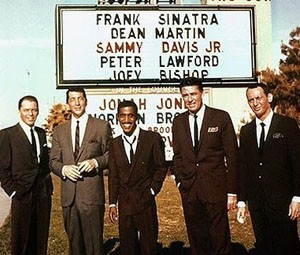
The Rat Pack was an informal group of singers that, in its second iteration, ultimately made films and appeared together in Las Vegas casino venues. They originated in the late 1940s and early 1950s as a group of A-list show business friends, such as Errol Flynn, Nat King Cole, Mickey Rooney, Judy Garland, Frank Sinatra and others who met casually at the Holmby Hills home of Humphrey Bogart and Lauren Bacall. In the 1960s, the group featured Sinatra, Dean Martin, Sammy Davis Jr., Joey Bishop, and Peter Lawford, among others. They appeared together on stage and in films in the 1950s and 1960s, including the films Ocean's 11 and Sergeants 3; after Lawford's expulsion, they filmed Robin and the 7 Hoods with Bing Crosby in what was to have been Lawford's role. Sinatra, Martin, and Davis were regarded as the group's lead members after Bogart's death.
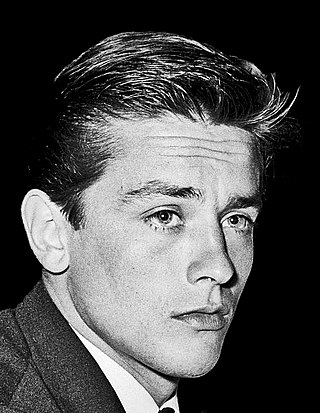
Alain Fabien Maurice Marcel Delon was a French actor, film producer, screenwriter, and singer. Acknowledged as a cultural and cinematic leading man of the 20th century, Delon emerged as one of the foremost European actors of the 1960s, 1970s, and 1980s, and became an international sex symbol. He is regarded as one of the most well-known figures of the French cultural landscape. His style, looks, and roles, which made him an international icon, earned him enduring popularity.

Quanah Parker was a war leader of the Kwahadi ("Antelope") band of the Comanche Nation. He was likely born into the Nokoni ("Wanderers") band of Tabby-nocca and grew up among the Kwahadis, the son of Kwahadi Comanche chief Peta Nocona and Cynthia Ann Parker, an Anglo-American who had been abducted as an eight-year-old child during the Fort Parker massacre in 1836 and assimilated into the Nokoni tribe. Following the apprehension of several Kiowa chiefs in 1871, Quanah Parker emerged as a dominant figure in the Red River War, clashing repeatedly with Colonel Ranald S. Mackenzie. With European-Americans hunting American bison, the Comanches' primary sustenance, into near extinction, Quanah Parker eventually surrendered and peaceably led the Kwahadi to the reservation at Fort Sill, Oklahoma.

The American Indian Wars, also known as the American Frontier Wars, and the Indian Wars, was a conflict initially fought by European colonial empires, United States of America, and briefly the Confederate States of America and Republic of Texas against various American Indian tribes in North America. These conflicts occurred from the time of the earliest colonial settlements in the 17th century until the end of the 19th century. The various wars resulted from a wide variety of factors, the most common being the desire of settlers and governments for Indian tribes' lands. The European powers and their colonies enlisted allied Indian tribes to help them conduct warfare against each other's colonial settlements. After the American Revolution, many conflicts were local to specific states or regions and frequently involved disputes over land use; some entailed cycles of violent reprisal.

Cynthia Ann Parker, Naduah, Narua, or Preloch, was a woman who was captured, aged around nine, by a Comanche band during the Fort Parker massacre in 1836, where several of her relatives were killed. She was taken with several of her family members, including her younger brother John Richard Parker. Parker was later adopted into the tribe and had three children with a chief. Twenty-four years later she was relocated and taken captive by Texas Rangers, aged approximately 33, and unwillingly forced to separate from her sons and conform to European-American society. Her Comanche name means "was found" or "someone found" in English.

Davy Crockett: King of the Wild Frontier is a 1955 American Western film produced by Walt Disney Productions. It is an edited and recut compilation of the first three episodes of the Davy Crockett television miniseries. The episodes used were Davy Crockett Indian Fighter, Davy Crockett Goes to Congress, and Davy Crockett at the Alamo. The film stars Fess Parker as Davy Crockett.

The "Old Three Hundred" were 297 grantees who purchased 307 parcels of land from Stephen Fuller Austin in Mexican Texas. Each grantee was head of a household, or, in some cases, a partnership of unmarried men. Austin was an American approved in 1822 by Mexico as an empresario for this effort, after the nation had gained independence from Spain. By 1825 the colony had a population of 1,790, including 443 enslaved African Americans. Because the Americans believed they needed enslaved workers, Austin negotiated with the Mexican government to gain approval, as the new nation was opposed to slavery. Mexico abolished it in 1837.

The Sons of Katie Elder is a 1965 American Western film in Panavision, directed by Henry Hathaway and starring John Wayne and Dean Martin. It was filmed principally in Mexico.

Yancy Derringer is an American action/adventure series that was broadcast on CBS from October 2, 1958, to June 4, 1959, with Jock Mahoney in the title role. It was broadcast from 8:30 to 9 p.m. Eastern Time on Thursdays.
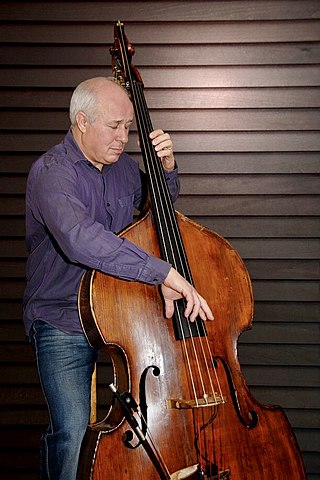
Chris Laurence is an English musician. Born in London, he studied at the Guildhall School of Music and Drama, and primarily works with jazz and classical music. In the classical world he was principal double bass with the Academy of St Martin in the Fields orchestra until 1995, playing on many of their recordings ranging from the film Amadeus to Benjamin Britten's Curlew River. He has recorded with many jazz artists, including trombonist J. J. Johnson, Tony Coe, Joe Williams, Sarah Vaughan, Clark Terry, Johnny Mathis, and Lena Horne. His most recent recordings include John Surman's The Spaces in Between (2007), Kenny Wheeler's The Long Waiting (2012) and Songs for Quintet on ECM Records, and Norma Winstone's Manhattan in the Rain (1998). He has also recorded music for television, film, and albums, most notably Leaving Las Vegas (1995), Ken Loach's Looking for Eric (2009), The Constant Gardener (2005), Howard Shore's score for Hugo (2011), and most recently was featured on the soundtrack of Mike Leigh's Mr. Turner (2014). In 2007, he recorded a CD with his own jazz quartet titled New View, released on the Basho label along with Frank Ricotti (vibes), John Parricelli (guitar), Martin France (drums), and featuring Norma Winstone (vocals).

The Council House Fight, often referred to as the Council House Massacre, was a fight between soldiers and officials of the Republic of Texas and a delegation of Comanche chiefs during a peace conference in San Antonio on March 19, 1840. About 35 Comanche men and women under chief, Mukwooru represented just a fraction of the Penateka band of the southern portion of the Comanche tribe. He knew he had no authority to speak for the Southern tribes as a whole and thus, any discussions of peace would be simply a farce. However, if Mukwooru could re-establish a lucrative trade with the San Antonian's perhaps a peace, by proxy, could be established. Just as the Comanche had done had been done for centuries in San Antonio, Santa Fe and along the Rio Grande River. They would rob one settlement and then sell to the other.

The Battle of Little Robe Creek, also known as the Battle of Antelope Hills and the Battle of the South Canadian, took place on May 12, 1858. It was a series of three distinct encounters that took place on a single day, between the Comanches, with Texas Rangers, militia, and allied Tonkawas attacking them. The military action was undertaken against the laws of the United States at the time, which strictly forbade such an incursion into the Indian Territories of Oklahoma, and marked a significant escalation of the Indian Wars. It also marked the first time American or Texas Ranger forces had penetrated the Comancheria as far as the Wichita Mountains and Canadian River, and it marked a decisive defeat for the Comanche.
The Texas–Indian wars were a series of conflicts between settlers in Texas and the Southern Plains Indians during the 19th-century. Conflict between the Plains Indians and the Spanish began before other European and Anglo-American settlers were encouraged—first by Spain and then by the newly Independent Mexican government—to colonize Texas in order to provide a protective-settlement buffer in Texas between the Plains Indians and the rest of Mexico. As a consequence, conflict between Anglo-American settlers and Plains Indians occurred during the Texas colonial period as part of Mexico. The conflicts continued after Texas secured its independence from Mexico in 1836 and did not end until 30 years after Texas became a state of the United States, when in 1875 the last free band of Plains Indians, the Comanches led by Quahadi warrior Quanah Parker, surrendered and moved to the Fort Sill reservation in Oklahoma.
Iron Jacket was a Native American War Chief and Chief of the Quahadi band of Comanche Indians.

Rosemary Forsyth is a Canadian-born American actress. She made her big screen debut in the 1965 Western film Shenandoah, for which she received Golden Globe Award nomination for New Star of the Year – Actress. Forsyth later starred in films The War Lord (1965), Texas Across the River (1966), Where It's At (1969), What Ever Happened to Aunt Alice? (1969), Some Kind of a Nut (1969), How Do I Love Thee? (1970), Black Eye (1974) and Gray Lady Down (1978).
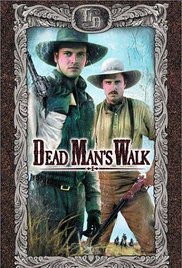
Dead Man's Walk is an American epic Western adventure television miniseries starring David Arquette as Augustus McCrae and Jonny Lee Miller as Woodrow F. Call. It was directed by Yves Simoneau. It is a two-part adaptation of the 1995 novel of the same name by Larry McMurtry and is chronologically the third book of the Lonesome Dove series, but regarded as the first events in the Lonesome Dove franchise. In this prequel to Lonesome Dove, it is 1840s Texas, and two young men join the Texas Rangers unit that is on a mission to annex Santa Fe. While the miniseries has been broken up into 3 parts for the DVD release, the series was originally broadcast by ABC over two nights in May 1996, and was later nominated for several awards.
